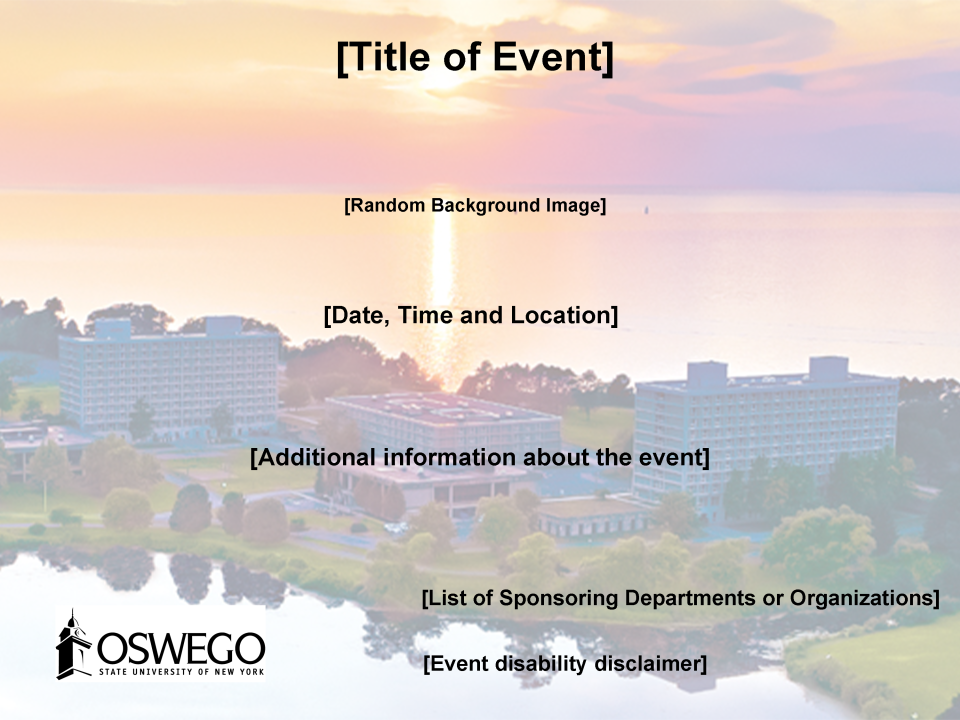The creation of content for the digital signage system requires a number of considerations. To help ensure your message is approved and effective, please read through and follow the guidelines below.
Consider the technical, aesthetic, and legal aspects, including:
- aspect ratio
- graphic readability
- colors and compatibility
- graphic style
- copyright laws
The technical considerations deal with the system's capabilities and limitations.
The aesthetic or creative considerations relate to making the digital slides and video visually interesting and effective communicators.
The legal considerations include copyright laws, what's allowed to be used, and what is not allowed.
Minimum Requirements
Content submitted for display on the digital signage system must meet the following minimum requirements before it will be approved and scheduled for display.
- Digital slides must be in PNG or JPEG format.
- Digital video must be 10 seconds or less in length and may not contain audio. Compatible digital video file formats are: .mov and .wmv.
- Digital slides or digital video using a solid red background will not be scheduled for display. Solid red backgrounds are reserved for emergency communications only.
- Do not incorporate elements into digital signage content that violate copyright laws.
- All digital signage content must be submitted to [email protected] 10 business days prior to the requested start date.
Digital Slides
Digital slides can be produced in any program that can create a PNG (portable network graphic) or JPEG/JPG (joint photographic experts group) file such as Microsoft Office PowerPoint, Photoshop and Canva.
Slide duration will be for a maximum of 21 days, including non-academic class days.
Aspect Ratio
It is important to realize that digital signage content should be created in a horizontal format. The areas of the digital signage screens reserved for display of digital slides use a 4 x 3 aspect ratio (4 units wide and 3 units tall). This means that when preparing digital slides the width of the slide should be approximately 1.77 times greater than the height. Digital slides with the following dimensions display best on the digital signage system: 1280 x 960 pixels, 1600 x 1200 pixels, and 1920 x 1440 pixels.
Readability
Digital slides are typically displayed for 10 to 15 seconds at a time. Therefore, it is best to limit the number of elements (text and graphic images) in a digital slide so that viewers have sufficient time to read the slide during its brief display time.
Text and Fonts
Limit the number of characters (letters, spaces, etc.) in a line and the number of lines on a slide. Forty characters or less is a preferred line length. A maximum of 10 lines per slide is a good target. Be sure to allow sufficient white space between and around text so that it appears balanced and visually pleasing.
The resolution limitations of the digital signage displays require the use of simple, bold text or type. It is best to avoid light, ornate fonts with fine thin lines or fonts with delicate serifs (even in larger sizes) because they are difficult to read. As a general rule of thumb, avoid font sizes smaller than 20 points.
Graphic Images
When using graphic images in digital slides, be sure to use images that are visually compatible with the other elements in the slide. Use images whose formats are compatible with creating slides in PNG and JPEG formats.
Color and Contrast
Other readability considerations are color and contrast. Insufficient contrast between text and background colors can make reading difficult. Some color combinations may provide sufficient contrast but still be difficult to view because one or more of the colors are extremely bright.
Copyrighted Material
Do not incorporate elements into digital slides that infringe upon the copyright or trademark rights of others. Digital signage content that infringes on the copyrighted or trademarked works of others will not be approved for display. Copyrighted and trademarked material may include, but are not limited to, logos, digital images, photographs, paintings, movies, videos, and written works.
For more information, see this copyright and fair use overview.
Digital Video
Digital video can be created in any program that can save the video in one of the following file format: .mp4 or .wmv.
Audio
Digital video may not contain audio. Digital video content with audio will not be approved for display, because the digital signage software does not recognize audio.
Questions about digital signage content requirements should be directed to [email protected].
